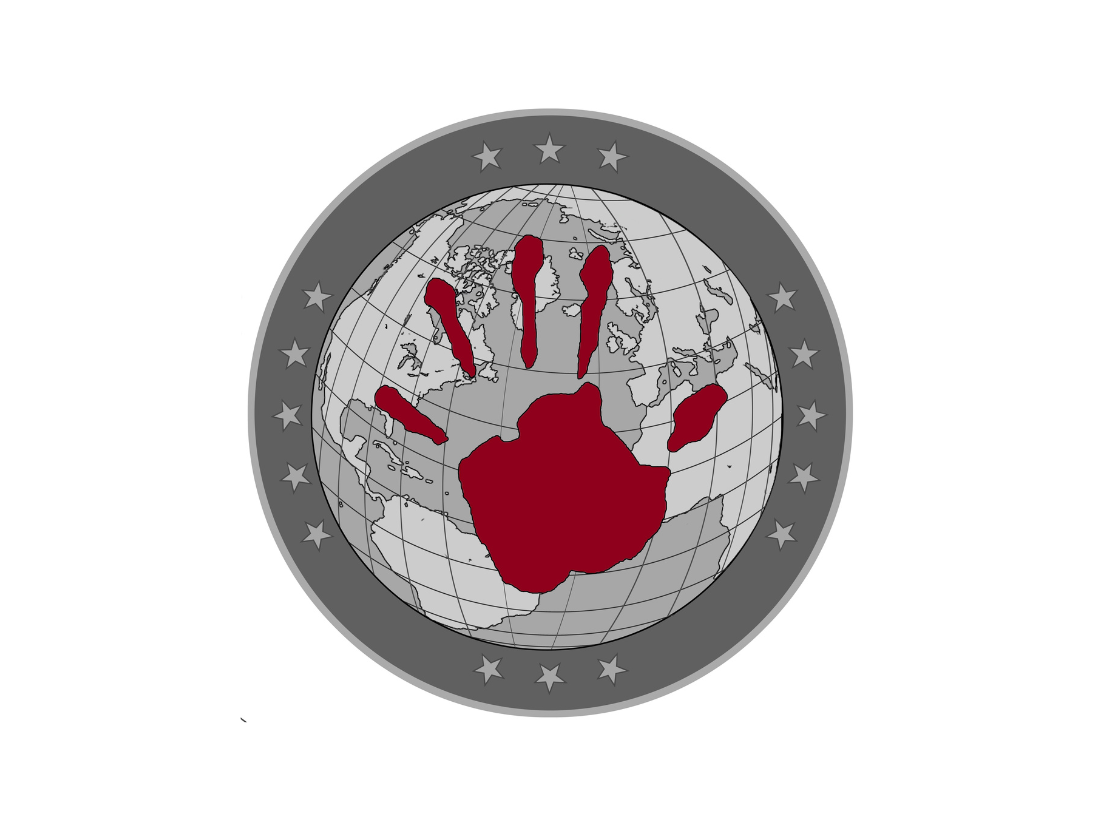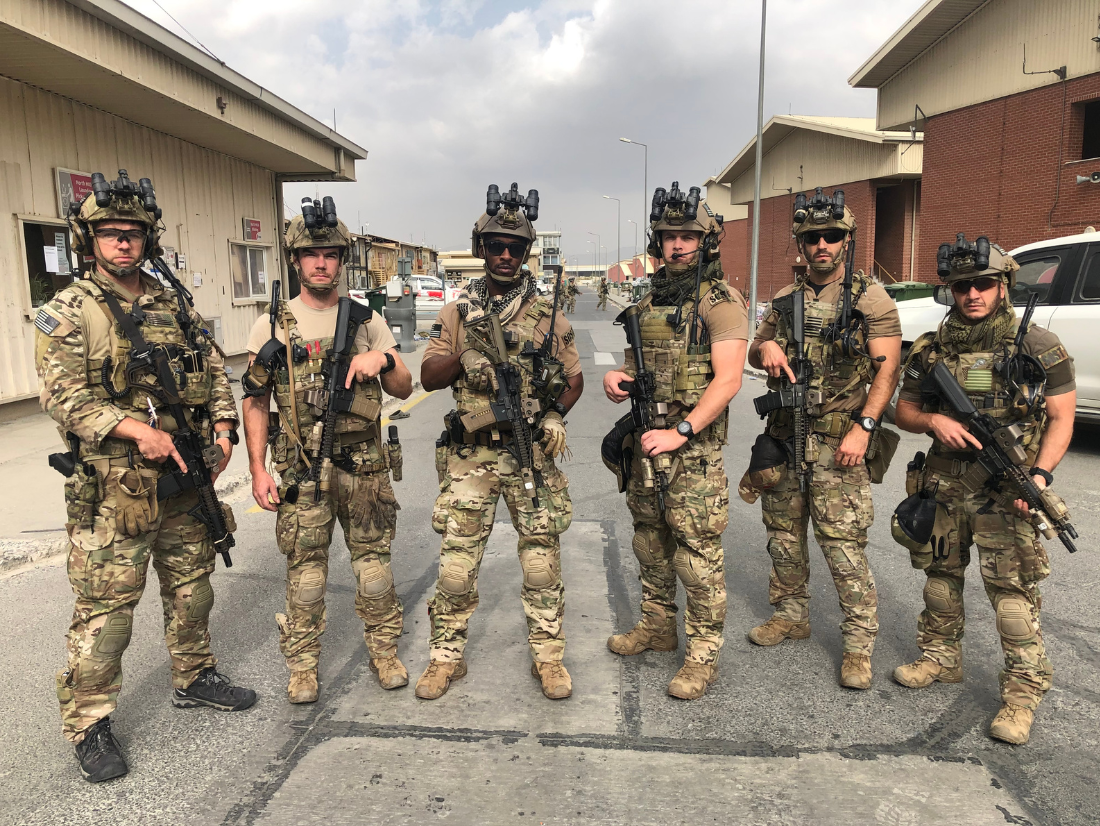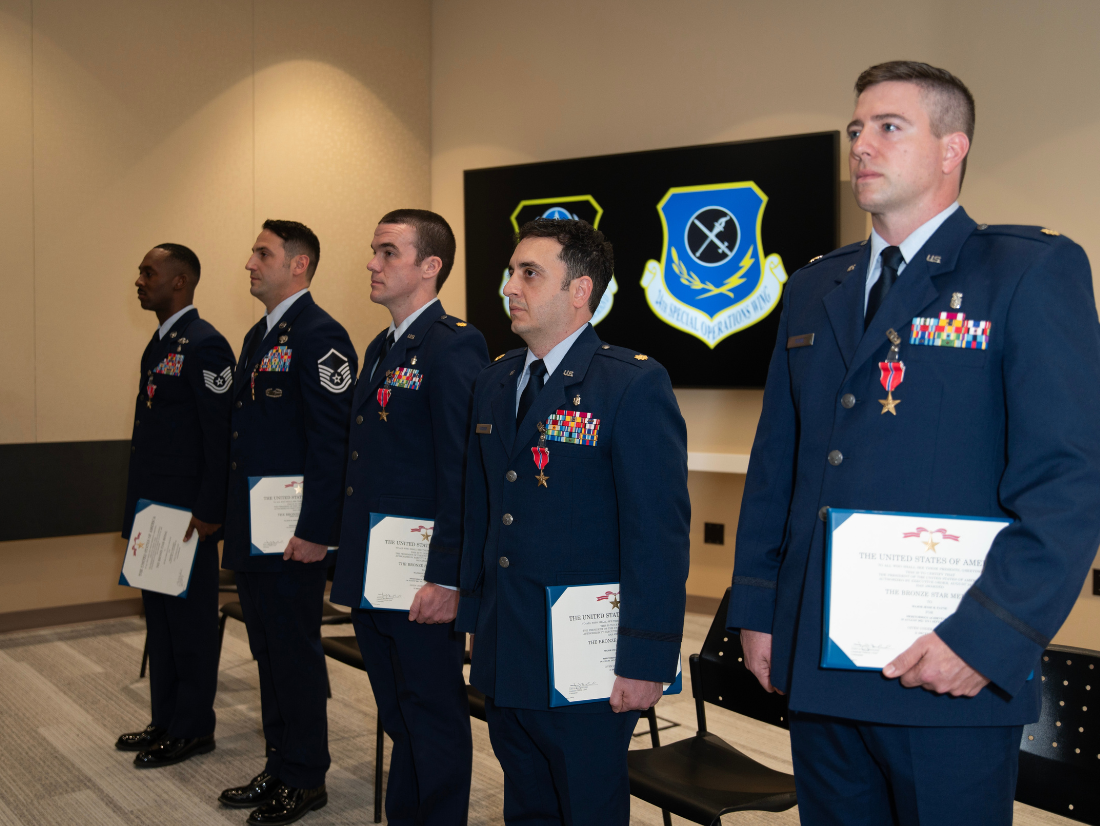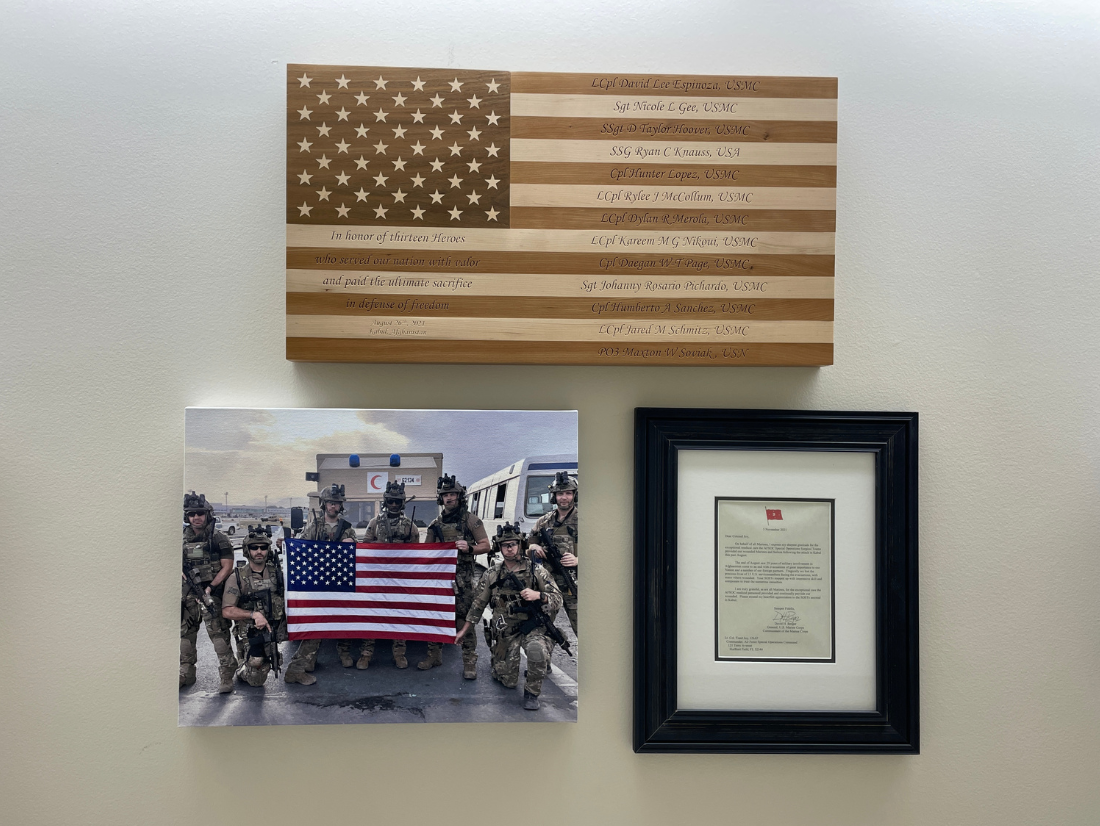 August, 2021. Birmingham, Alabama. After working an overnight trauma call at UAB Hospital, six healthcare professionals gathered for a routine Friday morning meeting to discuss how their shift went. They didn’t know that within 48 hours, they would be bound for Kabul, Afghanistan, to join the dangerous and deadly effort to evacuate American citizens, allies, and Afghan refugees.
August, 2021. Birmingham, Alabama. After working an overnight trauma call at UAB Hospital, six healthcare professionals gathered for a routine Friday morning meeting to discuss how their shift went. They didn’t know that within 48 hours, they would be bound for Kabul, Afghanistan, to join the dangerous and deadly effort to evacuate American citizens, allies, and Afghan refugees.
They didn’t know, but they were ready. Their entire training, including that shift they took together the night before in UAB’s trauma bays and operating rooms, prepared them for this very moment.
These six men were all active-duty members of the U.S. Air Force and made up an elite group - a Special Operations Surgical Team, or SOST. UAB has four SOST teams whose members are all embedded at UAB as credentialed faculty and staff. The particular UAB team that deployed to Afghanistan in 2021 was: Lt. Col. Adam Braden, anesthesiologist. Maj. Jesse Payne, critical care nurse and team lead; Maj. Omar Rokayak, D.O., surgeon and SOST Chief Medical Officer; Maj. Colin King, emergency physician; Master Sgt. Brandon Blake, respiratory care practitioner and team sergeant; Tech. Sgt. Ryan Bygraves, operating room technician.
Besides their medical training in their individual specialties, SOST members are also highly skilled in special operations training - meaning they can enter an austere, dangerous area with active warfare going on, defend and protect themselves and the injured, and provide the best medical care possible with the equipment on their backs - over 100 lbs worth of “battle rattle” - including their helmets, weapons, ammo, and medical equipment, medications, and fluids. Sgt. Blake even takes a portable ventilator in his pack.
They would all be putting their specialties to life-saving work in just a few days. After saying goodbye, I love you, and “don’t watch the news” to their loved ones, the team headed to Hurlburt Field in Florida (where their 24th Special Operations Wing and Air Force Special Operations Command is based), packed their equipment, and were on their way to Hamid Karzai International Airport in Kabul, Afghanistan.

Landing in Afghanistan
The situation on the ground was dire - hundreds of thousands of Afghan citizens, U.S. citizens, and other foreign nationals were desperately trying to leave after the Taliban takeover of the country. The U.S. had recently announced a complete withdrawal and deployed six thousand U.S. troops to evacuate U.S. and allied personnel, as well as Afghan allies. Kabul’s airport was the only secure route out of the country.
The UAB SOST team linked up with another SOST team from Las Vegas and came up with a plan to take rotating trauma shifts at the military treatment facility near the airport to provide extra coverage. This facility operated like a small hospital for operations happening in Afghanistan, and had a full staff of conventional military medical providers - but no special operation capabilities. Fortunately, the evacuation of these conventional assets had not yet occurred when the worst took place.
Over the next few days, the UAB SOST team spent their days location-scouting for potential casualty collection points in preparation for the withdrawal of all conventional medical personnel and in case they needed to treat injuries away from the facility with just the equipment in their packs. Their nights were spent taking trauma shifts at the facility, caring for civilians with injuries due to heat, crowding, explosives, and desperation - like ankles broken from jumping over fences and children burned in the midst of crowd-induced chaos.
A deadly suicide bombing
In the afternoon of August 26, following a night trauma shift and a day reconnaissance mission, the UAB team returned to the medical facility and was notified that the base was being locked down due to an imminent threat. An hour later, the team was allowed to head to their barracks to get as much rest as they could. 25 minutes later, as they wound down form their tasks and just prior to bunking down, their radio sounded the alarm. “MASCAL, MASCAL, MASCAL.” A mass casualty incident had occurred.
A suicide bombing by the airport’s Abbey Gate had injured hundreds of people. This would be the largest mass casualty incident of the preceding 10 years of the Afghanistan War.
The team quickly put their gear back on, gathered their equipment, and tactically maneuvered to the medical facility. After about five minutes of helping set up a flow for patients with their NATO counterparts and getting a lay of the land, trucks started pulling up with casualties.
For the next 15 hours straight, the two SOST teams, along with NATO medical personnel, worked nonstop to treat over 60 critically injured Afghans and military personnel.

Rokayak and his UAB team participated in at least four major operations. Ultimately, the ability of SOST and all other NATO medical assets to function as one large, integrated, cohesive team, regardless of branch of service or national origin, is what allowed the teams to ensure the highest degree of success in such a catastrophic situation.
“It really speaks to what can be done when there’s cohesion, lack of ego, and mission focus across the board,” he said.
Maj. Payne, the critical care nurse and team lead, says there was an attitude of “get in where you can fit in.” SOST members were treating their patients, flexing to the operating rooms, bouncing back and forth to different trauma bays and ICUs, doing anything to help out.
The facility only had two operating rooms, therefore some procedures were done in hallways, and some operations were done on stretchers and hospital beds, right beside another patient in the OR. The SOST teams used equipment out of backpacks.
“The different teams had only known each other a week and yet we were flowing and working so well together,” Blake, the respiratory care practitioner and team sergeant said. “You want to see the greatest piece of the United States and NATO military - it was everybody doing everything possible to take care of the many Americans, allies, and Afghan civilians that came through.”
Dawn was breaking by the time the last of the patients were cared for. At this point, the UAB team had been awake for nearly 40 hours without sleep.
“All of us sat on the edge of our beds and said, ‘what just happened?’” Blake remembers.
The care provided included over 15 major operations and countless life-saving interventions. Over 37 patients were evacuated to higher echelons of care outside of the country, others to hospitals in the country based on clinical appropriateness. This was one of the most rapid evacuations of casualties in Air Force history and the largest non-combatant evacuation airlift operation in U.S. military history.

170 Afghans lost their lives during the attack. So did 13 American service members - the majority died immediately on the scene. These young men and women had been deployed to help evacuate vulnerable people in a non-combatant operation.
“Those we lost, they were supposed to leave the next day,” Payne said. “They were supposed to be getting on that plane alive.”
Rokayak says it was “profound” to witness both the worst and best of humanity within a single 24-hour period.
“It was a day you saw indiscriminate violence inflicted on people who are trying to escape and have a better life,” Rokayak said. “On the same day, we saw the best of humanity through the efforts of everyone who worked endlessly throughout the day and night to save as many lives as possible.”
Rokayak says there aren’t enough words or acts to demonstrate his gratitude to the fallen heroes and gravely wounded from that day, let alone their families.
“They do all of this in service of a greater ideal,” Rokayak said. “It’s an incredible, difficult to understand sacrifice.”
After the bombing at Abbey Gate, the special operations teams became the last surgical assets on the ground as more evacuations took place. They were back on their trauma rotations, caring for casualties. They knew the plan was for all U.S. military to withdraw from Afghanistan. Following the evacuation of conventional medical assets, each SOST team collapsed into their preplanned austere casualty collection points and prepared to receive casualties as needed. Finally, each team was assigned a different plane on which to provide medical care if need be on the last flights out of Afghanistan, thus ensuring uninterrupted surgical and critical care capabilities.
On August 30, the UAB SOST team was on the second to last C-17 out of Afghanistan. Thus ended the nearly 20 year War in Afghanistan, the United States’ longest war.
“When we got up airborne and leveled out, that was the first time you saw everybody take a deep breath and realize, we’re going home,” Blake said.
SOST & UAB - an ideal match
Active-duty medical professionals don’t have many opportunities to practice trauma medicine in-between deployments due to lower volumes traumatic injuries on military bases. Medical treatment facilities on bases don’t typically see enough severe trauma cases for all medical personnel to remain ready and able to provide trauma care on the battlefield.
That’s where military-civilian partnerships come in.
UAB, as a high volume, ACS-verified Level I trauma center, is an ideal location to provide active duty Air Force personnel with the hands-on clinical experiences they need to maintain clinical excellence.

The partnership between UAB and the Air Force began in 2006, with UAB hosting Air Force combat medics and pararescue jumpers, or PJs, for two-week rotations to stay medically sharp between deployments. Now, nearly 150 PJs and medics a year come to UAB for training.
The first SOST team was embedded at UAB in 2010 and now there are four SOST teams - meaning UAB hosts 24 SOST health care professionals who are fully clinically integrated.
UAB sees 6,500 trauma evaluations a year. By taking trauma calls, the SOST team members are able to stay in “a state of constant readiness.”
SOST members take individual trauma calls usually twice a week, providing extra sets of hands to the current surgeons and staff at UAB. They also take one to three 24-hour calls a month with their specific SOST group, allowing them real-life experience handling cases together and giving them, as Rokayak explains, “limitless opportunities to perfect our ability to function together.”
They make sure to cross train everyone on the team in all the specialties as much as possible, because they never know what limitations they’ll face. They absorb knowledge from their civilian counterparts, and pick the brains of different specialists in burn care and neurosurgery to get a baseline understanding of how to treat patients with their minimal equipment.
What makes UAB so great is being able to work with top tier professionals who have been doing this for years and years,” Blake explained. “It allows us to be the best versions of ourselves when we get downrange.”
When they’re not in Birmingham, they’re often completing tactical training for delivering care in restrictive and challenging environments - whether that’s by air, sea, or land. Their training takes them to different climates - from tropical (Puerto Rico) to desert (New Mexico) to Artic (Alaska) to mountains (Romania).
Daniel Cox, M.D., UAB’s Trauma Medical Director and Chief of the UAB Trauma Service, is a Colonel in the Air Force Reserves and serves as Individual Mobilization Augmentee to the Air Force Special Operations Command (AFSOC) Command Surgeon. He previously served on an Air Force team embedded in Cincinnati and deployed to Afghanistan. He understands intimately what the embedded military personnel need to be successful.
“Clinically, because of the experience they get at UAB, they’re at the top of their game when they go out and deploy,” Cox said. “They are able to carry the high quality care that we do here directly out onto the battlefield for our wounded warriors.”
UAB - and its patients - benefit too
UAB’s trauma team is made up of a high percentage of active-duty service members and veterans - creating a culture of shared experiences and understanding.

Rokayak says he was able to work with legends in military trauma care, like Cox, John Holcomb, M.D. and Jeffrey Kerby, M.D., Ph.D. Holcomb is known as the “godfather of modern military trauma care" and is renowned researcher who served in the Army in Mogadishu, Somalia, where he was a part of the surgical team that delivered 48-hour non-stop care to soldiers during the battle that inspired the book and film Black Hawk Down. Kerby is an Air Force veteran and the Division Director for Trauma and Acute Care Surgery who originally brought PJs and SOST teams to UAB in 2006 and 2010 respectively.
“Any good that I'm able to do in the world wouldn't be possible without the mentorship that I’ve been so fortunate to have,” Rokayak said. “They’ve enormously impacted who I am and who I strive to be.”
After his SOST service, Rokayak stayed on at UAB to complete his formal fellowship in trauma and surgical critical care. Now, he’s a reservist SOST surgeon, and Medical Director of military-civilian partnerships at Virginia Commonwealth University in Richmond.
With any partnership, the benefits go both ways.
Rokayak was lead author on a paper published in the Journal of Trauma and Acute Care Surgery: The 16-year evolution of a military-civilian partnership: The University of Alabama at Birmingham experience. Co-authors include Drs. Cox, Holcomb, and Kerby. The paper highlights what makes the UAB mil-civ partnership successful, so other institutions can set up their own programs.

One of the few positive outcomes of war, as the paper explains, are the advancements gained from battlefield trauma care - and their integration into civilian trauma systems.
Examples include the ambulance system after the Civil War, blood banks after WWI, aeromedical evacuation after Korea and Vietnam, and damage control resuscitation strategies, tourniquets, and whole blood use after Iraq and Afghanistan.
“UAB benefits from the constant advances from military medicine that we’re able to implement for our patients right here in Birmingham,” Cox explained. “We’re on the cutting edge of advancement in trauma medicine because of this relationship.”
The most recent example of battlefield medicine is now saving lives in Birmingham. Birmingham has become one of the first cities in the country to take whole blood on ambulances, providing the critically injured with whole blood therapy on the scene. UAB’s trauma center has a 96% survival rate - but the patient has to arrive alive. The sooner the blood can get into a patient who’s bleeding out, the better, and studies have found that no other single intervention has a greater impact on survival than getting blood in the field.
Back home
The UAB and Vegas SOST members were all awarded the Bronze Star Medal, which is for members of the Armed Forces for heroic or meritorious achievement or service in a combat zone.

Each member of UAB SOST team was recognized for diligent work, sound judgment, technical competence, exemplary leadership, devotion to duty, and the highest degree of professionalism.
“Without a doubt, service members and civilians are alive today because of the expertise and dedication of the member,” the award citation reads.
“The Bronze Star is something you get when you do something heroic,” Blake said. “But for us, we did our job. We did what we were trained to do and we were able to save the lives we were able to save.”
In their SOST office at UAB hangs a memorial to the 13 fallen service members killed on August 26, 2021.
"None of us are into accolades or self-advancement,” Rokayak said. “We do this because we believe in the mission and we believe in the value of the sacrifices that countless individuals and their families have made over the course of our nation’s history - including the 13 service members we lost. We are eternally indebted to those heroes and their families. It is a debt we can never truly repay but one that will forever drive us to continue our service to our nation as we strive to be worthy of such sacrifices.”